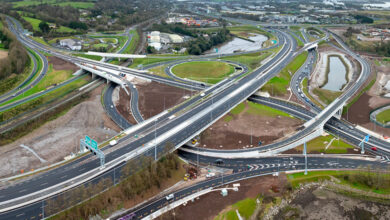A better drive with Egis
Egis Projects is deploying the latest technology to improve the efficiency of freight journeys, lower operational costs and improve safety on our roads.
In a new development from the Egis Group in France, its fully-owned subsidiary Easytrip Services is offering global road transport and smart mobility services. With a background in road operations, road maintenance and international tolling developments, Easytrip understands the needs of the transport and mobility industry. Moreover, our over 30 years of experience within the heavy goods vehicle (trucks) and mass market (light vehicles) industry has helped us to become a world class leader providing services such as toll solutions, tax refund, excise duty refund service, and ferry, rail and tunnel bookings.
Through its organisation of international and local subsidiaries, Easytrip is addressing a wide range of different markets with the focus on business-to-business and business-to-customer services. It has capitalised on its valuable customer knowledge, technical expertise and developed competencies in customer relationship management.
Because of fast-growing markets and the increase of the speed of changing business models, Easytrip also created the ability to work with integrated partnership environments, hence enlarging not only our scope of service but also strengthening competitive values. Easytrip Services is recognised as a leading player in the sector and is present across the whole value chain of road services.
Connected vehicles
Since 2010, Easytrip has conducted a profound market research programme in Europe about the development of the automotive industry and data connectivity coming into the vehicles. The emerging trend is clear: the internet will accelerate businesses, creating more value to fleet managers and end users. The focus of our market research was on all stakeholders in the transport industry who have an important role in the mobility transport chain in Europe.
Assiduous studies of markets like fleet telematics, roadside assistance, pay-as-you drive and pay-as-you-behave insurances, combined with upcoming government mandates related to centralisation of in-vehicle technology, the obligation of care of your fleet users and the overall safety of drivers (i.e. Ecall), completed our vision on how to further strengthen the strategy for the future.
By aggregating the Easytrip Services with the best in fleet telematics, Easytrip developed a unique offer for the transport and mobility industry. Not only do we follow the drivers’ routes, advise them the best in mobility solutions, but we also increase the awareness of the effects of taking a particular route and the related values influencing intelligence and support for taking proactive decisions.
Combining transport ‘mobility services’ with ‘mobility intelligence’, Easytrip will be able to provide the transport industry with a new dimension of managing and controlling fleets. We will move from passive fleet control into proactive fleet control.
Using high-end technologies and opening new ways to visualise mobility intelligence will further enable the transport industry to lower its total cost of operations (TCO). Where most transport companies believe that they have reached the best in lowering their TCO, Easytrip Services found new ways to assist them, thus lowering the TCO even further. Easytrip Services will introduce the first new features of this service from June onwards.
Speed cameras save lives
Egis’ intelligence-led approach to monitoring speed is continuing to save lives on Irish roads. This started with the introduction of privatised mobile safety cameras in November 2010, with a view to increasing compliance with speed limits and reducing driver fatalities. Vehicle speeds at locations with a speed-related collision history have dropped with the cameras acting as a deterrent to speeding.
The operator (GoSafe) is an Egis Projects joint venture with MIL (Ireland) and Redflex (Australia). GoSafe is paid per hour of roadside traffic monitoring (and not by infringements) and the programme is managed by An Garda Síochána.

Enforcement priorities are guided by statistically-supported knowledge gathered from the key stakeholders involved in road safety which selects the relevant locations and ensures optimal deployment of the safety cameras. Monitoring only occurs within these zones and is weighted towards the times at which collisions occur. Deployment is reviewed continually to ensure that most focus is placed on zones where drivers are less compliant with speed limits, thereby increasing the deterrent effect of the highly visible safety cameras. The camera vans monitor speeds across every county in the State and gather data that support and contribute to the intelligence-led enforcement approach.
An Garda Síochána also opted for overt monitoring with highly visible safety camera vans and the locations of all monitoring zones published at www.garda.ie and provided for satnavs, and all monitoring zones marked with roadside camera signs.
Mobile camera operations also have a ‘halo effect’ i.e. the length of time during which the effects of enforcement on driver behaviour continue after the enforcement has ended and the distance over which the effects of enforcement continue after passing an enforcement site. This allows a relatively small number of mobile safety cameras to have a larger impact on driver behaviour than a similar number of fixed cameras.
The intelligence-led approach, focusing on collision-prone zones, with a highly visible presence of mobile safety cameras seems to be achieving critical mass and contributing to saving lives. Crucially, it has been supported by a very extensive media campaign by the Road Safety Authority to emphasise the need to reduce speeds in the collision-prone zones and thereby save lives.
For more information on Easytrip Services, please contact
Marcel van Empel via email: marcel.van-empel-ext@egis.fr
Egis Project’s Ireland office can be contacted as follows:
Unit 24, Northwood House
Northwood Business Park
Santry, Dublin 9
Tel: +353 1 469 1200
Email: information@egis.ie
Web: www.egis.ie






